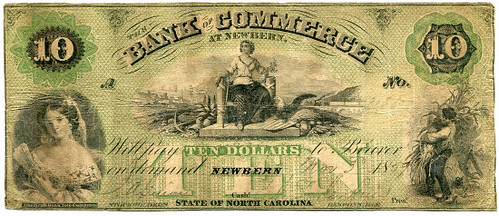
PREV ARTICLE
NEXT ARTICLE
FULL ISSUE
PREV FULL ISSUE
BANKNOTES OF NEW BERN, NORTH CAROLINA
Here's another article featuring colonial currency from a European perspective. Ruedi Kunzmann of Zurich Switzerland published this
article in the October 8, 2015 issue of CoinsWeekly. -Editor
New Bern, that sounds quite similar to Bern, the capital of Switzerland. As a matter of fact, this American town in North Carolina was founded early in the 18th century, by nearly 100 immigrants from Bern, under the leadership of high-ranking citizens who bore such names as von Graffenried, Ritter, Isot, and Michel. They were complemented by a few Anabaptists, which were rather unpopular in Bern, as well as 600 Palatines from Great Britain, the migration route leaving virtually no other option than to cross England. Likewise part of the endeavor was the explorer and well-known writer John Lawson. After having received written permission to establish a settlement by Anne, Queen of England, on August 22, 1709, the immigrants embarked on their journey to the young British colony. They successfully crossed the Atlantic Ocean and arrived in British Carolina where they founded New Bern in late autumn 1710. Historiography informs us that severe hostilities between the settlers and the Tuscarora Indians broke out only a couple of months later. During one such conflict, John Lawson was taken captive and killed, while New Bern was almost completely destroyed by the Indians. Many of the settlers lost their lives as well. As early as 1712 and thanks to the help of British troops, however, the Indians were defeated. The surviving colonists decided to stay. After only a short period of time, New Bern became an important city, with thriving agriculture and trade. The conditions were particularly favorable for New Bern to which a truly universal concept applied: it will be only possible for the necessary infrastructure to develop if streets and rivers facilitate the exchange of goods, if families are started and schools are founded, if all sorts of shops are established, and if the church is able to start its missionary work (the latter being valid for past times). All this was possible in the newly founded city. It is that era from which our first numismatic testimonies come: the banknotes. 
British Colony Carolina, colonial currency, 40 shillings, March 9, 1754 This rather early banknote still states the British denomination, shillings, while omitting any clear textual reference to New Bern. The note’s illustration, though, shows the city’s first Anglican Church building that was erected in the early 1750s. As will become clear a bit later, it is quite possible that this banknote was likewise printed there. New Bern grew more and more important in other regards as well: the first judicial academy was built there, and the Royal Governor, William Tryon, chose New Bern as the capital of the Royal Colony of North Carolina in 1766. The governor’s home, Tryon Palace, thus became the first permanent capitol of the British administration. By the mid-19th century, New Bern developed into an important center of export, on a national, American scale but also in regard to the trade with European countries. Back then, some 5,000 to 6,000 people lived in New Bern that was connected to other American cities by railroad. Banks were established, in order to improve cash flow. 
Bank of Commerce at New Bern. 10 dollars, November 3, 1839 As listed in the literature on banknotes, in the time between 1830 and 1860, New Bern had a total of six banks which illustrate the city’s importance: the Bank of Commerce at Newbern, the Merchants’ Bank of Newbern, the Bank of New Bern, as well as the Second Bank of North Carolina, the Bank of the State of North Carolina, and the State Bank of North Carolina, all of which had branches in New Bern where their own banknotes were issued. To read the complete article, see:

Wayne Homren, Editor The Numismatic Bibliomania Society is a non-profit organization promoting numismatic literature. See our web site at coinbooks.org. To submit items for publication in The E-Sylum, write to the Editor at this address: whomren@gmail.com To subscribe go to: https://my.binhost.com/lists/listinfo/esylum All Rights Reserved. NBS Home Page Contact the NBS webmaster 
|